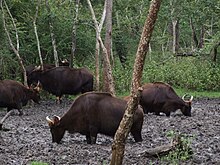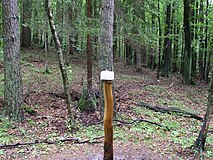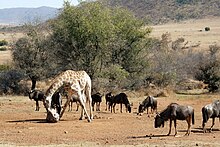Mineral lick

Amineral lick(also known as asalt lick) is a place whereanimalscan go tolickessentialmineral nutrientsfrom a deposit ofsaltsand otherminerals.Mineral licks can be naturally occurring or artificial (such as blocks ofsaltthat farmers place inpasturesforlivestockto lick). Natural licks are common, and they provide essential elements such asphosphorusand thebiometals(sodium,calcium,iron,zinc,andtrace elements) required forbone,muscleand other growth inherbivorousmammals such asdeer,moose,elephants,hippos,rhinos,giraffes,zebras,wildebeests,tapirs,woodchucks,fox squirrels,mountain goats,porcupines,andfrugivorousbats.[1]Such licks are especially important inecosystemssuch as tropical rainforests and grasslands with poor general availability of nutrients. Harsh weather exposes saltymineraldeposits that draw animals from miles away for a taste of needed nutrients. It is thought that certainfaunacan detectcalciumin salt licks.[2]
Overview
[edit]Many animals regularly visit mineral licks to consumeclay,supplementing theirdietwith nutrients and minerals. In tropical bats, lick visitation is associated with a diet based on wild figs (Ficus), which have very low levels of sodium,[3][4]and licks are mostly used by females that are pregnant or lactating.[5]
Some animals require the minerals at these sites not for nutrition, but to ward off the effects of secondary compounds that are included in the arsenal of plant defences againstherbivory.[6]The minerals of these sites usually containcalcium,magnesium,sulfur,phosphorus,potassium,andsodium.[7][8][9][10]Mineral lick sites play a critical role in the ecology and diversity of organisms that visit these sites, but little is still understood about the dietary benefits.
The paths animals made to natural mineral licks and watering holes became the hunting paths predators and early humans used for hunting. It is hypothesized that these salt and water paths became trails and later roads for early humans.[11]
Nonetheless, many studies have identified other uses and nutritional benefits from other micronutrients that exist at these sites, includingselenium,cobaltand/ormolybdenum.[12][13]In addition to the utilization of mineral licks, many animals suffer fromtraffic collisionsas they gather to lick salts accumulated on road surfaces. Animals also consume soil (geophagy) to obtain minerals, such as moose from Canada mining for minerals from the root wads of fallen trees.[14][15]
Artificial salt licks
[edit]Artificial salt licks are used in thehusbandryoflivestockand to attract or maintainwildlife,whether it be for viewing, photography, farming, or hunting purposes.[16]Maintaining artificial salt licks as a form ofbaitingis illegal in some states in the United States, but legal in others.[10]: 413 Inadvertent salt licks may lead to unintended wildlife-human interactions.[17]
-
Svärdsjö sheep, an endangered Swedish local breed, licking salt
History
[edit]In the Americas
[edit]Theindigenous peoples of the Americasand thelonghunterwatched salt licks to hunt game. Many became well-known, includingBledsoe LickinSumner County, Tennessee;theBlue Lickin centralKentucky;'Great Buffalo Lick' in Kanawha Salines, now present-dayMalden, West Virginia;theFrench Lickin southernIndiana;and the Blackwater Lick inBlackwater, Lee County, Virginia.[18][unreliable source?]
Mythology
[edit]InNorse mythology,before the creation of the world, the divine cowAuðumblalicked salty ice for three days and uncoveredBúri,ancestor of thegodsand grandfather ofOdin.On the first day as Auðumbla licked, Buri's hair appeared from the ice, on the second day his head, and the third his body.[19]
See also
[edit]References
[edit]- ^Bravo, Adriana; Harms, Kyle E.; Stevens, Richard D.; Emmons, Louise H. (2007)."Collpas: Activity Hotspots for Frugivorous Bats (Phyllostomidae) in the Peruvian Amazon".Biotropica.40(2). Wiley: 203–210.doi:10.1111/j.1744-7429.2007.00362.x.
- ^C. Michael Hogan. 2010.Calcium.eds. A.Jorgensen, C.Cleveland. Encyclopedia of Earth.National Council for Science and the Environment.
- ^Bravo, Adriana; Harms, Kyle E.; Emmons, Louise H. (2012)."Keystone resource (Ficus) chemistry explains lick visitation by frugivorous bats".Journal of Mammalogy.93(4): 1099–1109.doi:10.1644/11-mamm-a-333.1.
- ^Bravo, Adriana; Harms, Kyle E. (2017)."The biogeography of sodium in Neotropical figs (Moraceae)".Biotropica.49(1): 18–22.
- ^Bravo, Adriana; Harms, Kyle E.; Emmons, Louise H. (2010). "Puddles created by geophagous mammals are potential mineral sources for frugivorous bats (Stenodermatinae) in the Peruvian Amazon".Journal of Tropical Ecology.26(2): 173–184.doi:10.1017/s0266467409990472.
- ^Voigt, C. C.; Capps, K. A.; Dechmann, D. K. N.; Michner, R. H.; Kunz, T. H. (2008)."Nutrition or detoxification: Why bats visit mineral licks of the Amazonian rainforest".PLOS ONE.3(4): e2011.Bibcode:2008PLoSO...3.2011V.doi:10.1371/journal.pone.0002011.PMC2292638.PMID18431492.
- ^Emmons, L. H.; Stark, N. M. (1979). "Elemental composition of a natural mineral lick in Amazonia".Biotropica.11(4): 311–313.doi:10.2307/2387925.JSTOR2387925.
- ^Black, J. G.; Mosquera, D.; Guerra, J.; Loiselle, B. A.; Romo, D.; Swing, K. (2011)."Mineral licks as diversity hotspots in lowland forest of eastern Ecuador".Diversity.3(2): 217–234.doi:10.3390/d3020217.
- ^Ayotte, J. B.; Parker, K. L.; Gillingham, M. P. (2008)."Use of natural licks by four species of ungulates in northern British Columbia".Journal of Mammalogy.89(4): 1041–1050.doi:10.1644/07-MAMM-A-345.1.
- ^abAtwood, T. C.; Weeks, H. P. (2003). "Sex-specific patterns of mineral lick preference in white-tailed deer".Northeastern Naturalist.10(4): 409–414.doi:10.2307/3858657.JSTOR3858657.
- ^"A Brief History of Salt".Time.1982-03-15.ISSN0040-781X.Retrieved2018-04-16.
- ^Mills, A.; Milewski, A. (2007). "Geophagy and nutrient supplementation in the Ngorongoro Conservation Area, Tanzania, with particular reference to selenium, cobalt and molybdenum".Journal of Zoology.271(1): 110–118.doi:10.1111/j.1469-7998.2006.00241.x.
- ^Ayotte, J. B.; Parker, K. L.; Arocena, J. M.; Gillingham, M. P. (2006)."Chemical composition of lick soils: Functions of soil ingestion by four ungulate species".Journal of Mammalogy.87(5): 878–888.doi:10.1644/06-MAMM-A-055R1.1.
- ^Rea, R."Mining and geophagy of root wad soils by moose in winter"(PDF).Wildlife Afield.4(1): 86–87. Archived fromthe original(PDF)on 2012-03-25.
- ^Klassen, N. A.; Rea, R. V. (2008)."What do we know about nocturnal activity of moose?".Alces.44:101–109.
- ^"Managing the Deer Herd on Your Ranch | Hortenstine Ranch Company".Hortenstine Ranch Company.2017-10-03.Retrieved2018-10-03.
- ^Elassar, Alaa (22 November 2020)."Canadian officials warn drivers not to let moose lick their cars".CNN.Retrieved3 December2020.
- ^"My Long Hunters - Blackwater, VirginiaBlackwater, Virginia - My Long Hunters".mylonghunters.info.
- ^Prose EddabySnorri Sturluson
Further reading
[edit]- Kurlansky, Mark (2002).Salt: A World History.Walker and Co.ISBN0-8027-1373-4.
External links
[edit] Media related toSalt licksat Wikimedia Commons
Media related toSalt licksat Wikimedia Commons



